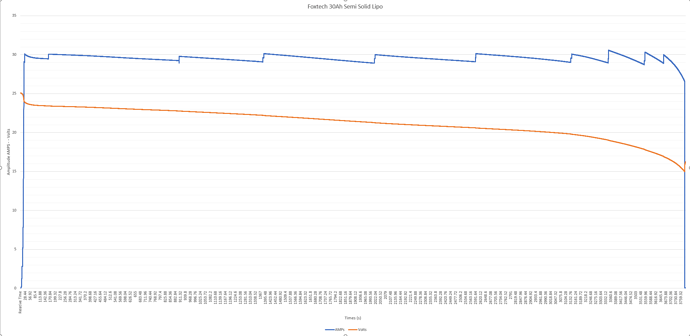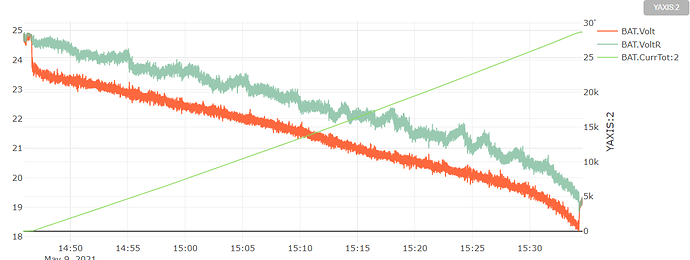we have used on heavy lift agriculture drone and works great.
So 6 months later I finally have got some more time to work on battery testing.
This is in regards to the Foxtech 30AH 6S Battery.
I built a battery testing rig that allows me to pull a constant current and dump the power into a set of high power low ohm resistors. This allows a much more precise and controlled measurement of the batteries capacity and drain curve.
This is particularly important for the Foxtech “Semi-solid lipos” becuse in order to get near the rated capacity you need to drain to an unusually low voltage level compared to the normal Li-po we typically use. This setup lets me keep an eye on the voltage of the whole battery and each cell. With this setup I can keep draining the battery until the voltage starts to drop off quickly and stop before damage occurs (hopefully).
Thus I was able to get an idea for a “safe” minimum discharge level for these cells. Here is the graph of voltage and current over time:
These measurements were taken with a lab grade DAQ and current shunt.
The current was manually adjusted by varying the duty cycle on a DC motor controller feeding the resistors, hence the jumps, I tried to keep it as close to 30A as possible. The test took about 62.5 Min.
During this test 29.36AH was drained from the battery, might have been able to get all the way to 30Ah at a lower discharge rate or if I took the voltage even lower, but I certainly would not drain them lower than the 2.5V per cell that I did here outside of the lab. When approaching 2.5V per cell (15V total) the spread of the min / max cell voltage was approaching 100mV. it was very tight <15mV for the first 90% of the test and after resting it quickly got back to that level.
This is quite impressive since these 30AH batteries are within 5% of the same size and weight of the Tattu 25AH LiHV batteries (which are already pretty impressive).
Once I write some automation for this I will do more tests to see how repeatable this is and try to make the data available.
Cool to see this! The data is interesting, but the test setup is interesting as well?
I’ve been toying with the idea of making a full battery SOC & SOH estimator. However, I need to figure out the parameter acquisition side and getting it approachable for those without fancy electronic loads.
I do wonder what the batteries look like internally? If they are bunch of 6S 18650 packs in parallel I really hope they have some nice balancing going on internally.
From the looks of it my T- Drone 6s 30Ah Semi Solid State just looks like 6 large pouches in series. I will be posting a log tmmrow of a test flight I conducted with it - specifically showing the power characteristics as the data seems quite similar to the Foxtech batteries. Probably same source.
Nice to see real data!
Once I have everything refined I hope to release the plans / software for this battery tester. It’s not cheap to build but at least 2-4x less than a electronic load of the same size.
I can confirm the battery physically is built just like a normal 6S lipo.
Hey guys!
So just to preface before putting down my data. The battery this test is from is the 6s 30Ah T-Drone Semi-Solid State Li-Po battery. From what I can find online the two batteries (Foxtech and T-Drone) are very similar in appearance and specs. This leads me to believe that the two are manufactured in the same plant - which the data also shows to be the case.
Below is a graph showing raw voltage, estimated resting voltage, and total current consumption from a pure hover flight that pulled 35A - 40A. As you can see, I tested up to about 95% battery consumption before landing the aircraft. I am confident in the validity of this data as the sensor has been proven to be accurate (within 0.5%) on this flight (charged up the battery and compared mAh capacity) and several other flights.
I plan on also setting up some sort of testing rig where I can pull around 80-100A from the battery by pairing it with four large 1 Ohm resistors in parallel. This should lead to a 0.2 5Ohm resistance that pulls about 4x voltage at all times. So between 80ish to 100ish A. The battery claims 5C (while this test is more like 3C) - so it will be interesting to see the performance. I don’t plan on ever pushing near 3C continuous during my normal flights - but it would be nice to know the capabilities. The testing rig I have spec’ed will cost about $500 (fans, resistors, voltage cutoff, etc.) - so I will have to budget for this in my project. But hopefully I can get data within the next month or so!
Even though this isn’t the primary use case we got these batteries for, I decided to do a test flight on our medium sized quad as can be seen here (minus its legs):
Specs as Flown:
- 4 x 18" T-motor MF1806 Props
- T-motor MN5008 340 Kv Motors
- T-Motor F55A Pro II 4 in 1 ESC
- Cube Orange Autopilot
- Here3 GPS
- Herelink Control / Telem
- Custom CF Frame with some 3D printed arm / motor mounts
- LattePanda 864s Companion Computer + LTE modem (+280g).
- Foxtech Semi-Solid 30AH 6S Battery
- AUW was between 4.5 - 4.6 Kg
Flight Time was 82.5Min, mostly just hovering in place outdoors, fairly mild breeze. Without a payload, and removing some dead weight, I expect this could do 90min.
The current sensor reads a bit high so the total AH consumed is a bit more than reality, I would estimate about 29-29.5AH was actually used. I also would not recommend draining to this low of a level in typical useage.
Interestingly Ardupilot’s resting voltage calculation seemed to breakdown at some point and the value actually started rising a bit about 2/3 in.
Would you upload the log for this? I might be interested in looking into why the resting voltage increase occurs. Like you said it doesn’t make a lot of sense. Especially since your current draw is increasing just like you would expect.
Sure:
https://drive.google.com/file/d/1-Wv3dQxJwDRMQFNsgiwredFn_CMSF4iD/view?usp=sharing
I updated the battery capacity parameter from 14AH to 30AH right after takeoff, so that is why there were some battery warnings. I don’t know that the capacity parmentier has anything to do with the resting voltage calculation though.
Here is another flight I carried out on a no-payload quadcopter. I flew until my low battery failsafe kicked in (which was around 75% capacity). I have since moved the low battery warning a bit lower so that it RTLs around 75%.
Nonetheless got around 60 minutes of flight w/o payload at 75% usage.
They seem to be labeled as LIion. We’ve done extensive testing of the batteries (16 hours or so) and found out that their performance is way lower than stated by foxtech. According to their site they should be able to go down to 2.7V per cell but we’re experiencing power drops at 3.5V per cell.
A representative from foxtech we contacted told us that the website had labeled it wrong and that the actual minimum voltage is 3.0V per cell.
Strange behaviour.
That’s very odd, as you can see we haven’t had any trouble draining to below even 2.7V per cell.
It sounds like there is some sort of mix-up, and you either got just defective batteries or mislabeled batteries, and the rep might either be disingenuously trying to explain away the problem, or they are actually confused at what you have.
What C-Rate are you pulling during these power drops?
Thanks for the logs! For some reason after after a long time of estimating the resistance at 15 mili-Ohms something switches and the estimate grows until it reaches 95 mili-Ohms. Resting voltage gets computed from resistance.
I haven’t yet gotten around to creating a way to test the lines of code by feeding in your data to determine the possible problem.
Sorry for the late response. Around 80 amps, so 3.6C. We recently flew and the battery cut out at 21 v and the drone started descending.
Hi I tried it. I know the manufacturer. Not its not Lit Ion. Its lipo but why so light because its dry cell. Very new technology.
Hey everyone, it’s been a while and I’m wondering if anyone can share any longer term feedback on these packs? How are they comparing to packs like the Tattu 6S 25Ah HV mentioned?
We have been using them as our primary packs (we have 8 of them) and haven’t run into any issues yet. We have relegated the LiHV packs to other vehicles to avoid the chance of conflicting battery cutoff voltages.
I haven’t done any more comprehensive measurements yet so I can’t say how much of any capacity they have lost, but it certainly isn’t noticable after maybe 20 flights per pack or so.
Who is the manufacturer if you don’t mind saying? Is it WeLion?





